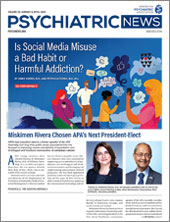Brain Scans May Indicate Optimal Treatment for Depression
Abstract
The degree of resting-state functional connectivity between brain regions involved in mood regulation hinted at depression patients most likely to respond to CBT or antidepressants.
Brain-based measures used in emerging research may help psychiatrists to personalize treatments for patients with major depressive disorder (MDD).

Helen Mayberg, M.D., says that research suggests there is a group of people who should not be prescribed an antidepressant because of their specific neural circuitry. Neuroimaging may one day help identify these individuals.
As it stands now—apart from weighing a wide-ranging set of symptoms or patient preference—psychiatrists often resort to a trial-and-error process, according to Helen Mayberg, M.D., a professor of psychiatry, neurology, and radiology at Emory University School of Medicine.
“We’re all looking for markers that will move us toward precision treatment, like our colleagues in cancer research who took the same stance and turned the field upside down,” she said.
While previous studies suggest psychotherapy and antidepressants in combination improve remission rates in MDD patients, the cost and time associated with this combination therapy can serve as barriers for some.
Mayberg together with Broadie Dunlop, M.D., director of the Emory Mood and Anxiety Disorder Program and W. Edward Craighead, Ph.D., a professor of psychiatry and behavioral science at Emory, set out to see if they could identify brain signatures capable of predicting how MDD patients receiving cognitive-behavioral therapy (CBT) or an antidepressant medication would respond.
Using functional MRI (fMRI), the researchers assessed the resting-state functional connectivity between the subcallosal cingulate cortex (SCC) and three other brain regions—the dorsal midbrain, the ventrolateral prefrontal cortex and anterior insula, and the ventromedial prefrontal cortex—in 122 patients with depression.
The patients, none of whom had received previous treatment for depression, were then randomly assigned to receive 12 weeks of CBT or treatment with one of two antidepressant medications: escitalopram or duloxetine. CBT consisted of 16 individual sessions, 50 minutes each. No placebo was used, and patients who did not remit after 12 weeks with a single treatment were offered combination treatment for an additional 12 weeks (CBT was added to medication nonremitters and escitalopram was added to CBT nonremitters).
Of the 122 participants, 58 achieved remission at weeks 10 and 12 (defined as a HAM-D score of ≤7), and 24 had treatment failure (defined as a <30 percent reduction from baseline HAM-D score at week 12). A total of 40 patients had intermediate outcomes.
Overall, patients with positive connections (greater functional connectivity) between the SCC and other regions examined were significantly more likely to achieve remission with CBT, while those with negative or absent connectivity were likely to remit to medication. Conversely, patients with positive connections did not remit when medications were used, and those with negative or absent connectivity did not remit to CBT. Some patients fell into a middle “gray zone,” which did not suggest a specific treatment.
Precision medicine should involve the prediction of both the desired outcome (remission) and the most undesired outcome (treatment failure), the study authors noted. “Severe consequences for choosing the ‘wrong’ treatment underscore the need for biomarkers predictive of both remission and treatment failure,” they wrote.
These emerging findings should help shape the prescribing patterns of clinicians, said Mayberg.
“A person who seeks out help from a psychiatrist and receives treatment is likely to get a first-line SSRI. If that doesn’t make the person better, the clinician should not assume the patient needs more drugs,” she said. “This research suggests trying psychotherapy instead. There is clearly a group of people who should never use a drug to get well.”
From a practical standpoint, Mayberg believes it is premature to advocate that brain scans be used now to determine the best treatments for depression patients in clinics because of cost and other considerations. Still, her findings in this area demonstrate the way imaging technology today may one day be used to personalize therapy for patients with MDD. (Another imaging study by Mayberg and colleagues, published in 2013, found evidence to suggest that using positron emission tomography [PET] to measure blood glucose in depressed patients might help predict response to CBT and escitalopram.)
Brain-based measures of major depression “may provide a basis for possible future algorithms for triaging subjects to the appropriate treatment, likely as a component within a multivariate approach to prediction,” the authors concluded.
This research, which appeared March 24 in AJP in Advance, was supported in part by the National Institutes of Health. Eli Lilly and Forest Laboratories donated the study medications, escitalopram and duloxetine, respectively, but were otherwise uninvolved in the study. ■
“Functional Connectivity of the Subcallosal Cingulate Cortex and Differential Outcomes to Treatment with Cognitive-Behavioral Therapy or Antidepressant Medication for Major Depressive Disorder” can be accessed here. Mayberg’s 2013 study, “Toward a Neuroimaging Treatment Selection Biomarker for Major Depressive Disorder” is available here.



